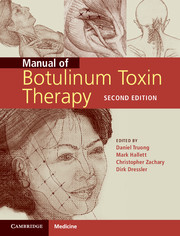Book contents
- Frontmatter
- Dedication
- Contents
- List of Contributors
- Preface
- Chapter 1 The pretherapeutic history of botulinum neurotoxin
- Chapter 2 Botulinum neurotoxin: history of clinical development
- Chapter 3 Pharmacology of botulinum neurotoxins
- Chapter 4 Immunological properties of botulinum neurotoxins
- Chapter 5 Treatment of cervical dystonia
- Chapter 6 Examination and treatment of complex cervical dystonia
- Chapter 7 Ultrasound guidance for botulinum neurotoxin therapy: cervical dystonia
- Chapter 8 Treatment of blepharospasm
- Chapter 9 Botulinum neurotoxin in oromandibular dystonia
- Chapter 10 Treatment of focal hand dystonia
- Chapter 11 Botulinum neurotoxin therapy of laryngeal muscle hyperactivity syndromes
- Chapter 12 The use of botulinum neurotoxin in otorhinolaryngology
- Chapter 13 Treatment of hemifacial spasm
- Chapter 14 Spasticity
- Chapter 15 The use of botulinum neurotoxin in spastic infantile cerebral palsy
- Chapter 16 The role of ultrasound for botulinum neurotoxin injection in childhood spasticity
- Chapter 17 The use of botulinum neurotoxin in spasticity using ultrasound guidance
- Chapter 18 The use of botulinum neurotoxin in tic disorders and essential hand and head tremor
- Chapter 19 Treatment of stiff-person syndrome with botulinum neurotoxin
- Chapter 20 Botulinum neurotoxin applications in ophthalmology
- Chapter 21 Cosmetic uses of botulinum neurotoxins
- Chapter 22 Hyperhidrosis
- Chapter 23 Botulinum neurotoxin A treatment for ischemic digits
- Chapter 24 Botulinum neurotoxin in wound healing
- Chapter 25 Use of botulinum neurotoxin in neuropathic pain
- Chapter 26 The use of botulinum neurotoxin in the management of headache disorders
- Chapter 27 The use of botulinum neurotoxin in musculoskeletal pain and arthritis
- Chapter 28 Treatment of plantar fasciitis with botulinum neurotoxins
- Chapter 29 Use of botulinum neurotoxin in the treatment of low-back pain
- Chapter 30 Use of botulinum neurotoxin in the treatment of piriformis syndrome
- Chapter 31 Ultrasound-guided botulinum neurotoxin injections for thoracic outlet syndrome
- Chapter 32 Botulinum neurotoxin in the gastrointestinal tract
- Chapter 33 Botulinum neurotoxin applications in urological disorders
- Index
- References
Chapter 21 - Cosmetic uses of botulinum neurotoxins
Published online by Cambridge University Press: 05 February 2014
- Frontmatter
- Dedication
- Contents
- List of Contributors
- Preface
- Chapter 1 The pretherapeutic history of botulinum neurotoxin
- Chapter 2 Botulinum neurotoxin: history of clinical development
- Chapter 3 Pharmacology of botulinum neurotoxins
- Chapter 4 Immunological properties of botulinum neurotoxins
- Chapter 5 Treatment of cervical dystonia
- Chapter 6 Examination and treatment of complex cervical dystonia
- Chapter 7 Ultrasound guidance for botulinum neurotoxin therapy: cervical dystonia
- Chapter 8 Treatment of blepharospasm
- Chapter 9 Botulinum neurotoxin in oromandibular dystonia
- Chapter 10 Treatment of focal hand dystonia
- Chapter 11 Botulinum neurotoxin therapy of laryngeal muscle hyperactivity syndromes
- Chapter 12 The use of botulinum neurotoxin in otorhinolaryngology
- Chapter 13 Treatment of hemifacial spasm
- Chapter 14 Spasticity
- Chapter 15 The use of botulinum neurotoxin in spastic infantile cerebral palsy
- Chapter 16 The role of ultrasound for botulinum neurotoxin injection in childhood spasticity
- Chapter 17 The use of botulinum neurotoxin in spasticity using ultrasound guidance
- Chapter 18 The use of botulinum neurotoxin in tic disorders and essential hand and head tremor
- Chapter 19 Treatment of stiff-person syndrome with botulinum neurotoxin
- Chapter 20 Botulinum neurotoxin applications in ophthalmology
- Chapter 21 Cosmetic uses of botulinum neurotoxins
- Chapter 22 Hyperhidrosis
- Chapter 23 Botulinum neurotoxin A treatment for ischemic digits
- Chapter 24 Botulinum neurotoxin in wound healing
- Chapter 25 Use of botulinum neurotoxin in neuropathic pain
- Chapter 26 The use of botulinum neurotoxin in the management of headache disorders
- Chapter 27 The use of botulinum neurotoxin in musculoskeletal pain and arthritis
- Chapter 28 Treatment of plantar fasciitis with botulinum neurotoxins
- Chapter 29 Use of botulinum neurotoxin in the treatment of low-back pain
- Chapter 30 Use of botulinum neurotoxin in the treatment of piriformis syndrome
- Chapter 31 Ultrasound-guided botulinum neurotoxin injections for thoracic outlet syndrome
- Chapter 32 Botulinum neurotoxin in the gastrointestinal tract
- Chapter 33 Botulinum neurotoxin applications in urological disorders
- Index
- References
Summary
The injection of botulinum neurotoxin (BoNT) for cosmetic purposes is the most commonly performed cosmetic procedure in the USA, with 4 million such procedures performed in 2011 alone (American Society for Aesthetic Plastic Surgery, 2011).
With time, overlying skin loses both its elasticity and thickness. This, coupled with repeated pleating and contraction of the skin over many years, will result in wrinkles. Cosmetically, the primary function of BoNT is to paralyze the muscles of facial expression. By relaxing the relevant underlying muscles of facial expression, BoNT will eliminate the so-called “dynamic” rhytids (wrinkles). Over time, even the appearance of static rhytids may be improved. In a 2007 study, patients reported looking 3 years’ younger than baseline 4 weeks after receiving BoNT to the upper face (Carruthers and Carruthers, 2007)
Currently (2012), there are three BoNT type A (BoNT-A) formulations with a cosmetic indication available in the USA: onabotulinumtoxinA (Botox, Allergan. Irvine, CA, USA), abobotulinumtoxinA (Dysport, Ipsen, Slough, UK) and incobotulinumtoxinA (Xeomin, Merz, Frankfurt/M, Germany). All are approved for the treatment of glabellar lines.
- Type
- Chapter
- Information
- Manual of Botulinum Toxin Therapy , pp. 181 - 193Publisher: Cambridge University PressPrint publication year: 2014
References
- 2
- Cited by



